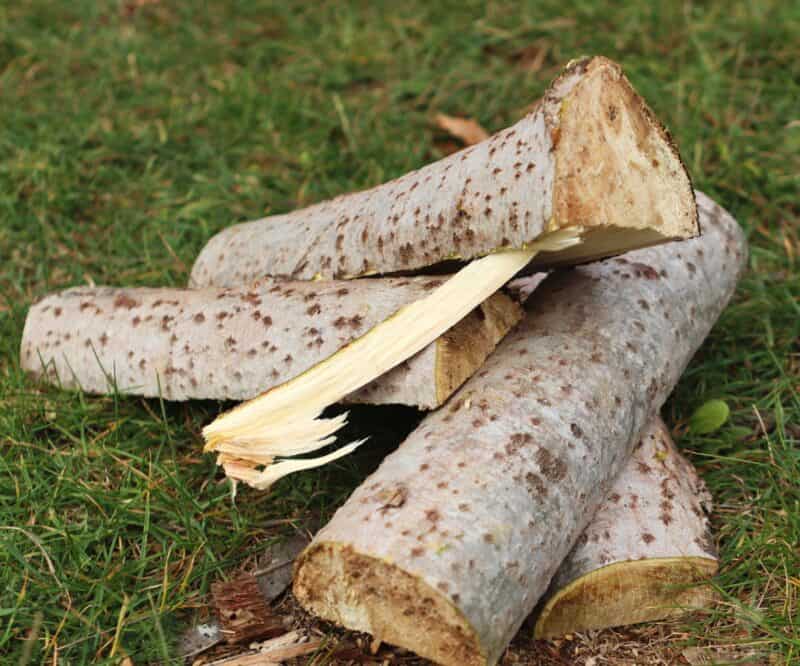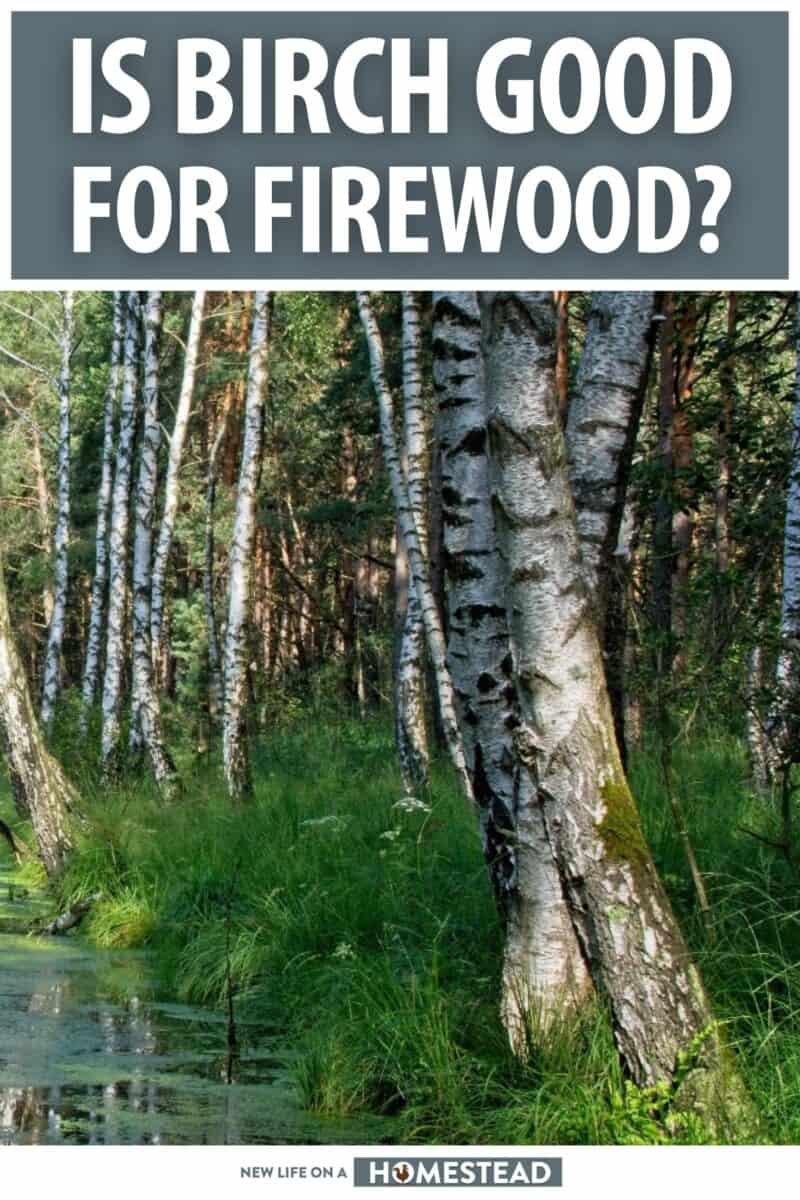by
Anyone who depends on wood for primary or supplementary heating knows that the choice of wood is nearly as important as managing the fire itself.

Every species of wood has unique properties that make it a better or worse choice than firewood.
Birch is certainly beautiful and plentiful, but how does it perform as firewood? Does it stack up against other hardwoods? Is birch good firewood or not?
Yes, birch is a solid choice for firewood. It is easy to find and harvest in many regions, it has a high BTU rating, and it burns hot and efficiently. It has a pleasant aroma and it is easy to split and season.
However, some users find that birch is smoky when burned, so it is important to manage the fire and sizing of firewood carefully.
Birch, as it turns out, is one of the best all-around firewoods you can get, and good compared to many other hardwoods and most softwoods.
You can do a whole lot worse than birch, especially if it is common in your area. Keep reading to get the full scoop on using birch as firewood.
Birch is Plentiful Throughout Much of the United States
One of the best things about birch as firewood is that it is easy to find in many parts of the United States.
Birch ranges from the Southern U.S. to Maine and all the way north and west to Alaska, so if you live anywhere in between, odds are good that birch is a locally-available resource.
Various birch species also happen to be common throughout the rest of the world in Europe, Asia, and North Africa.
And while birch might not be the most common tree in the world, it is certainly one of the more widespread species.
How Efficient is Birch Firewood?
Another great thing about birch is that it burns hot and efficiently. In other words, it has a high BTU rating. BTU, or British Thermal Units, is a measure of the heat energy contained in a given amount of wood.
The higher the BTU rating, the more heat energy contained in the wood, and thus the hotter it will burn and the longer it will last as fuel. In essence, you’ll get more warmth for the same volume of wood.
Birch typically has a BTU rating of around 20 to 26 million per cord depending on the species, with 26 million being on the high end for firewood.
For comparison, common varieties of hardwood like oak have a BTU rating of around 25 million per cord, while softwoods like pine tend to be closer to 21 million.
So what does this mean in practical terms? If you’re planning to burn a cord of wood to heat your home, you’ll usually get more heat from most birch woods than from an equivalent amount of pine, and pretty much all birch species beat most other softwoods by a mile.
What are the Burning Properties of Birch?
In terms of burning properties, birch is considered only moderately clean-burning wood.
Though it generally doesn’t produce a lot of sparks or embers it will often create a fair bit of soot or creosote buildup in chimneys. But when sized and burned properly, birch doesn’t produce too much smoke.
However, some users find that birch produces more smoke than other woods when burned improperly, and yellow birch in particular is slightly notorious for being smoky, especially compared to other birch species.
If your fire is not burning hot enough or if the birch is not dry enough, count on it being fairly smoky.
Therefore it’s important to try and season your birch firewood for at least six months (ideally 12 months for yellow birch) to ensure that it is completely dry before using it, and to build a hot, consistent fire to get the best results with it.
What’s the Aroma of Birch Like?
It might sound silly to the uninitiated, but the aroma of your chosen firewood is also a fairly important consideration.
Some woods smell nice, some smell mostly neutral and a few smell downright noxious. If you have any choice, you’d probably pick one of the first two options!
In this regard, I am happy to report that birch smells great. It has a light, pleasant scent that is often compared to incense or spices.
Some species are reported to smell of wintergreen; you might be surprised to learn that birch trees were often cultivated for making wintergreen oil in the past!
So if you’re looking for a wood that will make your home smell nice while it’s burning, birch is definitely a dependable option.
Considerations for Splitting and Storing Birch
Birch isn’t just a great performer when you are actually burning it. It also has a lot of good attributes when the time comes to process it.
For one thing, it is considered a relatively easy wood to split. The grain is generally straight, and the wood is not excessively hard, so most people don’t have too much trouble chopping it up for firewood.
However, you will need to work fast when bucking and processing birch as it has a tendency to rot quickly.
If you’re not able to get it split and stacked relatively soon after felling the tree, it’s best to leave it live and whole until you’re ready to use it, or at the very least get the bucked sections up off the ground.
Also, make it a point to peel the bark off of it if you can; it has a tendency to trap moisture in the fibers of the wood. Once cut into manageable pieces, birch can be stored like most other types of firewood.
How Long Should Birch Dry Before Burning?
Ideally, birch should be cut and split in the fall so it has plenty of time to dry over the winter months. If you’re cutting it yourself, try to wait until the sap has stopped flowing before chopping it up. If you’re buying already cut wood, make sure it was cut at least six months ago.
Once it’s cut, the birch should be stacked in a sheltered spot so it doesn’t get wet. As it dries, the birch will change color from white to pale yellow or brown.
You can test the moisture levels of your birch by taking a small piece and striking it against another piece of wood. If there’s a spark or shower of wood bits, that means there’s still too much moisture and it needs to dry out more.
If the birch cracks or breaks easily, that means it’s too dry and won’t provide as much heat when burned. The perfect piece of birch for burning should bend slightly without breaking.
Can You Burn Freshly Cut Birch?
You can burn freshly cut birch, but it’s not ideal. Fresh birch is full of moisture, which can cause the fire to smoke and produce less heat.
If you do choose to burn freshly cut birch, it’s best to season it first by stacking it in a dry location for several months. This will help to remove some of the moisture and make the wood easier to burn.
Selecting Your Birch Logs
When selecting birch logs for your fire, it’s important to look for dry wood with few knots or branches. Freshly cut wood tends to be more difficult to ignite and can produce more smoke than dry wood.
Before starting your fire, you should prepare your logs by cutting them into smaller pieces if needed. This will help promote airflow around the logs and make it easier for them to ignite once you light the match.
Additionally, it may be necessary to split large logs in order to reduce their size enough for burning. Splitting logs can also help increase drying time due to greater exposure of the inner layers of the log which may still contain moisture.
Be sure that you have all necessary equipment such as an ax or maul when splitting large logs; safety should always be your top priority when preparing firewood!
How to Store Extra Birch Firewood
The best way to store birch firewood is in a dry, ventilated area. A garage or shed is ideal, as long as there is plenty of airflow. If you live in a humid climate, you may need to take additional steps to prevent the wood from absorbing too much moisture.
One option is to store the wood off the ground on a pallet or in a wire basket. Another is to cover the stack of wood with a tarp or sheet of plastic.
Where to Find Birch Firewood – and How Much Does a Cord Cost?
Birch trees are actually relatively common – you can find them in many northern forests. As such, there’s no shortage of birch firewood on the market. Your best bet is to look for a local supplier who sells firewood by the cord.
The real challenge is finding a supplier who can provide you with a consistent supply of high-quality wood.
As for price, a cord of birch firewood will typically set you back between $100 and $200. That said, the cost can vary depending on the quality of the wood and the time of year. If you’re looking to save some money, it’s best to buy during the off-season when prices are typically lower.
Birch Bark is a Great Fire Starter
Speaking of birch bark, that iconic, papery bark is wonderful tinder and makes it easy to start a fire.
If you’ve ever gone camping and used a standard fire-starting method like a ferro rod or matches, you’ve probably noticed that it can sometimes be difficult to get a fire going without tinder.
Birch bark is a perfect, plentiful, and easy-to-ignite solution for that, and just as handy at home in the fireplace or stove.

No comments:
Post a Comment